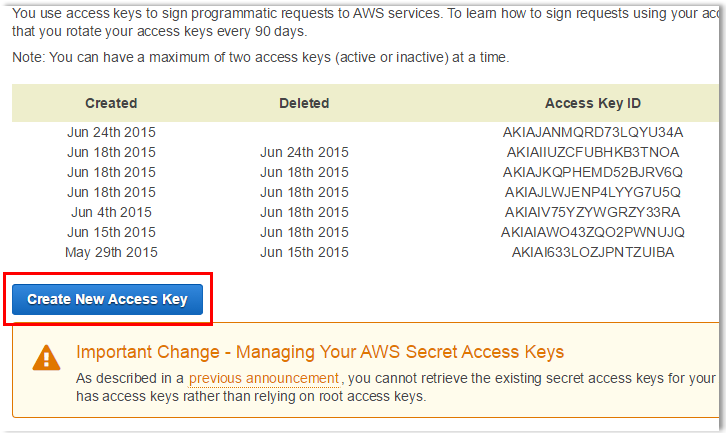Generate Secret Access Key Aws
This Python example shows you how to manage the access keys of your users.
- Generate Secret Access Key Aws Login
- Symbianize
- Generate Secret Access Key Aws Login
- Generate Secret Access Key Aws Server
The Scenario¶
Users need their own access keys to make programmatic calls to AWS from the Amazon Web Services (AWS)SDK for Python. To fill this need, you can create, modify, view, or rotate access keys(access key IDs and secret access keys) for IAM users. By default, when you create an access key, itsstatus is Active, which means the user can use the access key for API calls.
- Jul 14, 2017 How to create access keys in AWS? Login to your AWS console and navigate to this IAM dashboard part.This page helps you to manage your security credentials like password, MFA, access keys, certificates etc. Expand ‘ Access Keys (Access Key ID and Secret Access Key) ‘ and you will see space to create new access keys like below.
- AWS calculates the fingerprint differently depending on whether the key pair was generated by AWS or a third-party tool. If you created the key pair using AWS, the fingerprint is calculated using an SHA-1 hash function. If you created the key pair with a third-party tool and uploaded the public key to AWS.
Feb 21, 2018 Don’t Use Keys. The easiest way to secure a secret like a set of access keys (the AWS Access Key and AWS Secret Key) is not to create them in the first place. If it doesn’t exist, it’s impossible to lose! There are some use cases where access keys. Under access keys for CLI, SDK, and API access, click on the create access key button. Click on the show secret access key link. Copy both the access key ID and the secret access key into a secure password store, such as LastPass, 1Password, or a similar tool. Now, take note here. Choose Create access key and then choose Download.csv file to save the access key ID and secret access key to a.csv file on your computer. Store the file in.
Since you have logged-in via your Root account, you can generate an Access Key and Secret Key via the Security Credentials option via the top-right pull-down menu (the one with your name on the label).
In this example, Python code is used to manage access keys in IAM. The code uses the AWS SDK for Pythonto manage IAM access keys using these methods of the IAM client class:
- create_access_key.
- paginate(UserName='IAM_USER_NAME').
- get_access_key_last_used.
- update_access_key.
- delete_access_key.
For more information about IAM access keys, see Managing Access Keysin the IAM User Guide.
All the example code for the Amazon Web Services (AWS) SDK for Python is available here on GitHub.
Prerequisite Task¶
To set up and run this example, you must first configure your AWS credentials, as described in Quickstart.
Create Access Keys for a User¶
Create a new AWS secret access key and corresponding AWS access key ID for the specified user. Thedefault status for new keys is Active.
The example below shows how to:
- Create a new AWS access key usingcreate_access_key.
Example¶
List a User's Access Keys¶
List information about the access key IDs associated with the specified IAM user. If there are none,the action returns an empty list.
If the UserName field is not specified, the UserName is determined implicitly based on the AWS accesskey ID used to sign the request. Because this action works for access keys under the AWS account,you can use this action to manage root credentials even if the AWS account has no associated users.
The example below shows how to:
- List a user's access keys usingpaginate(UserName='IAM_USER_NAME').
For more information about paginators see, Paginators

Example¶
Get the Access Key Last Used¶
Get information about when the specified access key was last used. The information includes thedate and time of last use, along with the AWS service and region that were specified in the last requestmade with that key.
Generate Secret Access Key Aws Login
The example below shows how to:
- Get the access key last used usingget_access_key_last_used.
Example¶
Update Access Key Status¶
Change the status of the specified access key from Active to Inactive, or vice versa. This actioncan be used to disable a user's key as part of a key rotation work flow.
Symbianize
The example below shows how to:
- Change the status of an access key to Active usingupdate_access_key.
Example¶
Generate Secret Access Key Aws Login
Delete an Access Key¶
Delete the access key pair associated with the specified IAM user.
If you do not specify a user name, IAM determines the user name implicitly based on the AWS accesskey ID signing the request. Because this action works for access keys under the AWS account, you canuse this action to manage root credentials even if the AWS account has no associated users.
The example below shows how to:
- Delete an access key usingdelete_access_key.